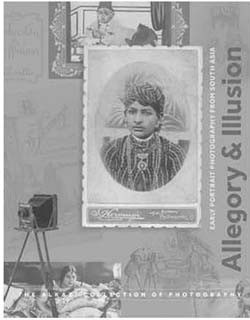As is being discussed worldwide, the age of digital technology has given a new lease of life to analogue photography. The ability to scan and make digital files out of old fragile negatives and paper prints has given impetus and ease to the facility of making visual archives. Here are two presentations that are a valuable gift to the connoisseur of the not so recent cultural history of the Indian subcontinent that have been made possible by the effort of The Alkazi Collection of Photography. The ACP as it is known is a pioneering effort of the Art collector, dramatist, gallery owner Ebrahim Alkazi who over years has slowly dug out photographic material, meticulously catalogued it and made a fantastic repository of research as well as exhibition material for anyone who wants to engage with visual form.
Dedicated to the portrait photography right from its very early days, the numerous images that form the rich collection of people’s photographs in Allegory And illusion draw immediate attention to the multi-layered purpose of engaging the self with a new scientific invention that was creating true likenesses of people who confronted it. Yet what was unique to the Indian sensibility was the confluence of traditional portraiture painting and this engagement with the indexical that is well drawn out in the essay. Photography in its Indian avatar continued to jostle the territory of reality and illusion. Many images shown here are rare examples of the hybrid nature of photography in India where the fascination to colour a Black and White photograph brings in the intervention of the painter artist who is coming from the tradition of court patronage and knows well to further elevate the status of his royal sitter by adding a glow to his eyes, a dash of gold to his turban or completely overlaying the entire frame with a rich scenario. The picture of Thakur Zorawar Singh of Kanota, attributed to a court photographer and artist is one such example. Attention is drawn towards what essayist Beth Citron has called Portraiture and Figuration. While both seek representation of the person, one conventional distinction is that the primary goal of portraiture is to reveal the likeness of the sitter, while figuration may or may not include verisimilitude in its form as it explores physical and psychological aspects of the human condition.
The author rightly claims that figuration has been a part of South Asian art since ancient times. Therefore we see such intervention with the brush and paint in many pictures. But beyond looking to be psychological painted photographs also tend to be aspirational. There is a beautiful lady in her parlour, supposed to be a Nepalese princess, the room has a blank window in the original photograph. In the painted version of the photograph a flower bed has been added just outside the window to hint at the desire for greenery. Similarly a very precious and significant double spread photograph in the book is of the large clan of Hakeem Ajmal Khan, a well known Delhi resident and freedom fighter where the entire architecture of the house is constructed as a painting with grand arches and inlay work, whereas the picture is taken against a flat background in a studio.

